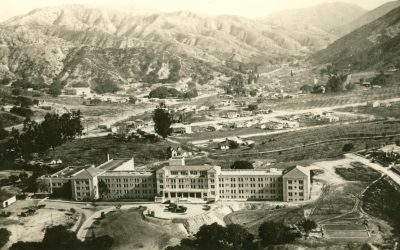Who is Ellen White?
Ellen G. White was one of the key co-founders of the Seventh-day Adventist Church. And though she lived most of her life in the Nineteenth century, she’s still making a revolutionary impact on millions of people around the world through her writings.
In this post, you’ll get an overview of who Ellen White was and why she is significant to the Adventist Church.
Here are 6 areas of her life that we’ll cover:
- Ellen White’s legacy
- Her early life
- Her middle life and service as God’s messenger
- The end of her life and ministry
- Her writing and speaking
- Her involvement in other initiatives in the society
Ellen White’s legacy
Ellen G. White was a woman of remarkable spiritual gifts who lived 87 full years (1827-1915). She dedicated 70 of these years to ministry in the founding and establishment of the Seventh-day Adventist Church.
Through her extensive writing and speaking, she provided lasting guidance that greatly influenced the leadership and development of the then young Adventist Church.
Here is a summary of her legacy:
- Smithsonian
 named her as one of the 100 most significant Americans of all time.
named her as one of the 100 most significant Americans of all time. - She served as God’s special messenger to call people’s attention to the Bible and Jesus’ soon return.
- Led by the Holy Spirit, she provided counsel for the early Adventist Church as an organization, and for individual members regarding different situations.
- She was a prolific writer of more than 5,000 periodical articles and 40 books. And today, her writings have been compiled to make up to 100 English titles. Her writings are under legal custody of the Ellen G. White Estate.
- She is the most translated woman writer in the entire history of literature, and the most translated American author of either gender.
- She was heavily involved in health reform during an unhealthy time for America, soon after the Industrial Revolution.
Let’s now take a dive into Ellen White’s life story. We’ll look at who she was and what she did, from her early life and ministry, to the end.
Ellen White’s early life
Ellen White was born to Robert and Eunice Harmon on November 26, 1827. Her maiden name was Ellen Gould Harmon. And together with her twin sister Elizabeth Harmon, they were the youngest in a large family with eight children.
 They lived on a small farm near the village of Gorham, Maine in the United States and later moved to Portland, Maine.
They lived on a small farm near the village of Gorham, Maine in the United States and later moved to Portland, Maine.
While walking home from school one day at the age of nine, an unfortunate accident changed her life forever.
One of her classmates threw a stone at her and hit her in the face. This injured her nose severely. After being unconscious for three weeks, she slowly recovered.
But even with the recovery, her physical health remained so frail that she had to end her formal education.
For some time, she had shaky hands and her eyes couldn’t see well when she attempted to read or write.
Nearly 50 years later, she looked back at this experience and said:
“This misfortune, which for a time seemed so bitter and was so hard to bear, has proved to be a blessing in disguise. The cruel blow which blighted the joys of earth, was the means of turning my eyes to heaven. I might never have known Jesus, had not the sorrow that clouded my early years led me to seek comfort in Him.”1
This is because though her physical health suffered greatly, God still prepared her for a great work ahead. A work where He would bless the world through her service, her intellect, and her devotion to Jesus as we’ll see.
Ellen White’s conversion
In 1840, she attended a Methodist camp meeting at Buxton, Maine with her parents. It’s at that meeting that she gave her heart to Jesus at age 12.
She later requested to be baptized at Casco Bay. With this, she became a member of the Methodist Church.
Also at this time in the US, several revival meetings were being held by the Millerite Movement.
It was led by William Miller, a farmer-turned-minister who preached that Jesus would return in a few years.
In fact, one Millerite, Samuel Snow, predicted that Jesus would return on October 22, 1844.
 Ellen White attended some of these meetings with her family. And in June 1842, she accepted the teachings and joined the Millerite Movement. With confidence, she looked forward to Christ’s second advent.
Ellen White attended some of these meetings with her family. And in June 1842, she accepted the teachings and joined the Millerite Movement. With confidence, she looked forward to Christ’s second advent.
Though naturally timid and reserved, she worked earnestly to show her young friends that Jesus was coming soon.
Then October 22, 1844 came, and Jesus did not come.
Like all the other Millerites, she was greatly disappointed.
But instead of giving in to despair, she joined those who decided to go back to study the Bible and pray for understanding about where they had gone wrong.
It’s at these meetings and studies that God began to use her as His messenger.
Ellen White’s middle life
From the age of 17 to her late 30s, Ellen White was instrumental in laying the foundation for the beginnings of the Adventist Church.
It all began on one December morning of 1844, when she was just 17 years old.
She was praying with four other women, when she received a vision from the Holy Spirit.
The vision showed the journey of the Advent people to heaven at the Second Coming. It showed that God had guided His people in the truths that had spurred their expectations of His return, and that they shouldn’t despise the experience they had gone through.
They’d later learn that though they were wrong on the event which was to happen on that day, something had happened that they needed to find out through further Bible study.
At first she was reluctant to tell others, even though she had been instructed in the vision to share it.
But then she received another vision, in which God instructed her to go and tell this and other future visions to the Advent believers.
And that’s how she got into a practice of public ministry for the rest of her life.
From then on, God provided guidance, encouragement and comfort to His people through her testimony.
In this section, we’ll look at the next 21 years of her life and ministry (1844-1865).
The areas we’ll look at include:
- Ellen White’s marriage and family
- How she got settled in her role as God’s messenger in the Church
- The beginnings of publishing her writings
- The organization of the Seventh-day Adventist Church
- Her involvement in health reform in Adventism
Let’s begin with her family life.
 Ellen White’s marriage and family
Ellen White’s marriage and family
In late August, 1846, Ellen married James White, a young Adventist preacher at the time. They met in Orrington, Maine, where she traveled to speak.
They were married for 36 years, until James’ death in 1881.
Together they had four sons: Henry, Edson, William, and Herbert.
Unfortunately, Henry died aged 16, and Herbert at just a few months. Only two of the boys grew to adulthood.
Discovery of the seventh-day Sabbath
James and Ellen learned about the Sabbath from a tract published by another prominent Adventist, Joseph Bates. This was just a few weeks after their marriage.
The tract’s title was Seventh-day Sabbath. It showed from Scripture that the seventh day was still the biblical Sabbath.
Being convinced that the views were biblically correct, they began to keep Saturday as the Sabbath instead of Sunday.
 Then six months later, on April 3, 1847, Ellen White received another vision, this time on the Sabbath.
Then six months later, on April 3, 1847, Ellen White received another vision, this time on the Sabbath.
In it she saw a temple in heaven, in which were the Ten Commandments. And on the fourth commandment, which is the Sabbath commandment, there was a light encircling it.
This vision both confirmed the importance of the Sabbath doctrine and gave believers confidence in it.2
From this time on, James, Ellen, and Joseph Bates worked together to unite the Advent believers on the Sabbath message.
These three formed the nucleus that led to the founding of the Seventh-day Adventist Church.
Ellen White as God’s messenger
The Sabbath vision is a good example of how Ellen White’s visions and counsels were helpful in the development of Adventist doctrines or initiatives.
Usually, the members of the church would study the Bible about a topic that came up. They’d pray for understanding of God’s Word, and that they could unite in understanding about a given belief. And in many situations, God would give Ellen White a vision that confirmed their understanding to be correct.
 This was the case in other key Adventist beliefs like the heavenly sanctuary.
This was the case in other key Adventist beliefs like the heavenly sanctuary.
Due to this, the Advent believers came to regard Ellen White as having the gift of prophecy. A gift just like one of the other spiritual gifts listed in Romans 12:6-8, 1 Corinthians 12:8-10, and Ephesians 4:11.
Ellen White herself never referred to herself as a prophet. She was very clear that she was only “the Lord’s Messenger.”3
But she exhibited striking similarities to Bible prophets in various ways.
From the way she received the visions to the nature of her messages, which were always in line with Scripture, the goal was always to point people back to the Bible (Isaiah 8:20).
She also passes the biblical tests for a true prophet found in the Bible.4
Because of this, those in the Advent Movement believed the messages were from God. That she was God’s messenger for the church, their modern day prophet.
The visions were varied and catered to different contexts like:
- Church doctrines, initiatives, and general state of the church
- About heaven
- The end times
- How Bible prophecies have been fulfilled in history
- Explaining unfulfilled Bible prophecies that are yet to happen
- Issues on current events during her time, like the American Civil War
- Specific individuals who were members of the church
As they continued to study Bible prophecies, Adventists found that one of the key characteristics of God’s people in the end times is that they would have something called “the testimony of Jesus Christ” (Revelation 12:17, NKJV).
Then Revelation 19:10 defines the testimony of Jesus as the “spirit of prophecy.”
And being Adventists with a firm belief that Jesus was coming soon, they knew they should strive toward the characteristics of God’s people as Revelation described.
So, Ellen White’s prophetic gift was welcome since it fit with the biblical description. And her writings are often referred to as “Spirit of Prophecy” or “Testimonies,” since they were inspired through the prophetic gift.
However, it’s important to note that not all her writings or talks were inspired.
Since she was an average human being, with relationships and a life just like any of us, she had some “common writings” too. Things like letters to her children, diary entries about her day to day homemaking, and letters to friends and relatives.
So it’s always important to differentiate between writings she outrightly states she received from God, and her other writings. Though reading even the common writings is always refreshing since she was generally a wise woman, with remarkable intellect and excellent common sense.
Today, one of the fundamental beliefs of the Adventist Church has to do with the gift of prophecy demonstrated by Ellen White.
And this demonstration has been preserved through her writings. Let’s look at how she began publishing her writings in the first place.
Beginning to publish her writings
The work of publishing the Ellen G. White writings became easy and efficient after the establishment of Adventist publishing houses.
This began when on November 18, 1848, Ellen White received a vision.5
In it, she saw that her husband was to begin publishing a small paper containing Bible truth and sending it to the scattered Advent believers. This would then grow into the massive publishing work that has always been part of the Seventh-day Adventist Church.
So, James White started publishing a paper called The Present Truth in the summer of 1849.
It contained articles by Ellen White on various subjects.
 By 1851, Ellen White had written and published her first book, which is now part of the book Early Writings, pages 11-127.
By 1851, Ellen White had written and published her first book, which is now part of the book Early Writings, pages 11-127.
She continued contributing to other periodicals that James put out until finally, the believers in Battle Creek, Michigan decided they would build a little printing house, which made publishing much easier.
In March 1858, she received another vision about a spiritual conflict described in the Bible. A conflict between Christ and His angels and Satan and his fallen angels that began before the creation of the earth and which will continue to the end of the world.
She published it in a 219-page book titled Spiritual Gifts, volume 1, The Great Controversy Between Christ and His Angels and Satan and His Angels, in the summer of 1858.
The book was well received by the church with its eye-opening description of biblical end time scenes.6
This struggle between God and Satan, (and therefore good and evil) came to be known as the Great Controversy. It has become one of key Adventist beliefs and a critical context to keep in mind when studying the Bible.
Organization of the Adventist Church
In the early 1860s, Ellen White was occupied with efforts to set up church and conference organizations. This organization became necessary to enable systematic management of different aspects of the fast growing movement.
Finally in May 1863, they organized into a denomination as the General Conference of Seventh-day Adventists.
Ellen White and the health reform initiative
Around this time, many of the church workers were suffering from poor health and even death due to overwork and other preventable causes.
So two weeks after the organization of the church, Ellen White received another vision on the relation of physical health to spirituality.
It showed the importance of following good principles in self care. It also highlighted the benefits of nature’s remedies—pure air, sunshine, exercise, and pure water.
In diet, vegetarianism was shown to be healthier than the meat-based diets that were common during her time.
 She started advocating the importance of health reform to the church leaders.
She started advocating the importance of health reform to the church leaders.
Soon, the health message came to be seen as part of the message of Seventh-day Adventists.
Then she and James compiled and published 64-page pamphlets called Health, or How to Live .
On Christmas Day of 1865, Ellen White received another instruction. That Seventh-day Adventists should establish a health institute to care for the sick and to teach people about healthy living.7
The first one was opened in September 1866—the Western Health Reform Institute.
And from this, they continued to establish health clinics, which has matured to the vast Adventist healthcare system we know today.
End of life and ministry
After its organization, Ellen White remained to be a strong nurturing influence to the Church.
She continued to write and travel to encourage believers and help pioneer missionary efforts at home and abroad.
It’s also during this period that her husband’s health began failing, until he died in 1881.
In this section, we’ll look at her life and ministry from 1866 to the end of her life in 1915.
We’ll explore her involvement in:
- Broadening the denomination’s work to the West Coast
- Establishment of Adventist education system
- Beginning of the denomination’s work overseas
- Her travels to Europe and Australia
- Her role in the reorganization of the Church
- Her last days
Broadening the denomination’s work to the West Coast
In 1872-1873 James and Ellen White went to California and started working on projects in the Pacific Coast.
Then on April 1, 1874, Ellen White received another vision.
In it, she saw how the denomination’s work was to expand and develop in the western states and also overseas.
This led to having evangelistic meetings in Oakland, California in just a few weeks.
James White also began publishing the magazine Signs of the Times. Then he set up a publishing house, the Pacific Press.
By early 1878, the church had started a health institution near St. Helena, California.
When Ellen White saw it, she exclaimed that she’d seen those same buildings and surroundings in the 1874 vision!
Ellen White and the establishment of Adventist education system
In 1872, a man named Goodloe Bell started a small school for some Adventist youth who wanted to learn.
It became the first school sponsored by the Adventist Church.
 To encourage the Church’s educational pursuits, Ellen White wrote a pivotal essay titled “Proper Education.”
To encourage the Church’s educational pursuits, Ellen White wrote a pivotal essay titled “Proper Education.”
The principles she presented in this essay remains as the blueprint of Adventist education to this day.
By Fall 1874, the Church opened its first educational institution, the Battle Creek College.
At the college’s dedication on January 4, 1875, Ellen White shared that she’d been shown another vision the day before concerning the church’s role in spreading the gospel internationally.
So, the Battle Creek college became the first of many colleges to train missionaries for the gospel work, both at home and abroad.
Beginning of the denomination’s work overseas
In the April 1, 1874 vision, Ellen White saw the church’s mission work expanding overseas.
She saw that printing presses would be set up in other lands away from America. That well-organized work would develop in vast world territories that Adventists had never thought of entering.
And with calls for a missionary to be sent to Europe, she encouraged the church to venture abroad. That same year, the Church sent John N. Andrews to Europe as its first overseas missionary.
There, he started a publishing house in Switzerland and a French periodical.
The headquarters of the work in Europe was set up in Basel, Switzerland.
From this point on, many more mission stations were established in other parts of the world.
Her travels to Europe and Australia
Between 1885 and 1900, Ellen White traveled internationally twice with her son William:
First to Europe for about 2 years, and later Australia for 9 years.
Europe
From 1885 to summer of 1887, the General Conference sent Mrs. White to visit the European missions. This was after her husband’s death in 1881, so she went with her son William White.
She spent time at the headquarters, and also made trips to England, Germany, France, Italy, Denmark, Norway, and Sweden.
That’s when she got to see and recognize the printing presses she’d seen in her January 3, 1875 vision! They were now located in Basel, Switzerland, and Christiana (now Oslo), Norway.
Through her counsels, she greatly influenced the establishment of right policies and plans for the work in Europe.
She also made two trips to the Waldensian valleys in Italy.
 Here, she visited places she had seen in vision in connection with the Dark Ages and the Reformation. It was an important part of the book The Spirit of Prophecy, volume 4 that had been published in 1884 (which was an expansion of the Great controversy vision she had seen in 1858).
Here, she visited places she had seen in vision in connection with the Dark Ages and the Reformation. It was an important part of the book The Spirit of Prophecy, volume 4 that had been published in 1884 (which was an expansion of the Great controversy vision she had seen in 1858).
It covered the Great controversy story from the destruction of Jerusalem to the end of the world.
After she returned to America, she edited the book to spell out the details of the scenes involving those places in Europe. The result was the book known today as The Great Controversy. It was first published in 1888, and later revised in 1911.
She then attended the GC Session of 1888 in Minneapolis, Minnesota.
There, she saw the need to encourage the Church to have a Christ centered message. So in the following months, she traveled and preached, seeking to unify the Church on the doctrine of righteousness by faith.
She also worked on her masterpiece, the book Steps to Christ, which was published while she was in Australia in 1892.
It focuses on showing how we can become practical, loving, and lovable Christians through a relationship with Jesus.
Australia
By 1891, the Church was pioneering the work in Australia.
Again, the Church’s leaders asked Mrs. White to go and help with this work through her counsel.
She reached Australia in December 1891. Again, she traveled with her son W. C. White and several assistants.
And just like in Europe, Mrs. White recognized the printing presses in Australia as among those she’d seen in the January, 1875 vision.
Soon after her arrival, she advocated for the establishment of Avondale College.
Then in 1894, she helped organize the territory into a union conference—the first administrative structure of its kind in Seventh-day Adventist history.
And apart from giving counsel, she also gave financially to support the Australian mission.
In the end, a health institution was established, and many churches built.
She also wrote articles weekly for the different periodicals in North America and maintained correspondence with denominational leaders.
And by the time she returned to America in 1900, she had four more books published. One of these was the Desire of Ages, an excellent commentary on the life of Jesus.
Back in the US, she made her home at Elmshaven, near St. Helena in northern California.
Then she traveled to attend the GC session of 1901 in Battle Creek, Michigan.
Her role in reorganization of the Adventist Church
At the 1901 GC Session, she boldly called for a reorganization of the work of the General Conference.
Due to the Church’s fast growth, there was a need to distribute responsibilities among more church leaders. Up to this time, only a few men held leadership positions from the structure set up during the beginning days of the denomination.
So, they adopted the Australian plan of union conferences as intermediate organizations between the General Conference and local conferences.
Then different departments were set up.
She also advised that the General Conference be moved from Battle Creek to the East Coast.
And two years later, the denominational headquarters, together with the Review and Herald Publishing Association moved to Takoma Park, Maryland near Washington DC.
Ellen G. White’s final years
During and after the time of the Church’s reorganization, Ellen White wrote intensely.
Books like The Ministry of Healing, Education, Testimonies for the Church, volumes 7 and 8 were published by 1905.
She also encouraged the opening of medical missionary educational work on the Pacific Coast.
This resulted in a college at Loma Linda and the Paradise Valley Sanitarium near San Diego.
At the age of 81, Ellen White attended the 1909 GC session in Washington.
In her talks, she emphasized some basics of the Adventist faith—conversion, healthy living, evangelism and the three angels’ messages.
And at the end of her very last address, she picked up the Bible, opened it, and held it up with trembling hands. Then she firmly stated:
“Brethren and sisters, I commend unto you this book.”
 That was to be her last General Conference session.
That was to be her last General Conference session.
And what a final charge she gave to the church leaders! The Bible was to be where their proceedings started and ended.
She went home and intensified her efforts to finish a number of books on various essential instructions to the Church.
She churned out 5 books by the end of 1914.
Then on the morning of February 13, 1915, she fell and broke her left hip. And for the next five months she was confined to her bed or wheelchair.
Finally, she died on July 16, 1915, at the age of 87.
She was laid to rest at her husband’s side in Oak Hill Cemetery, Battle Creek, Michigan.
Overview of her writing and speaking
The messages that God gave His people through Ellen G. White were delivered through her speaking and prolific writing. Through these avenues, they provided counsel, warnings, encouragement, and even called out harmful behaviors she noticed.
Through writing
Ellen G. White was more than a gifted writer. 
Consider the fact that she only had formal education to the age of nine. And though she desired a theological training, her physical frailty couldn’t allow her to pursue this line of education.
Yet, she was led by the Holy Spirit to write widely, addressing a variety of topics in religion, education, social relationships, evangelism, prophecy, publishing, nutrition, and management.
Through her pen, God provided guidance on various issues during her time and for the formation and growth of the Church.
But even today, the same guidance remains relevant for both the Church and the believers.
Over the years, her writings have been compiled into titles covering specific areas. For example:
- Religious topics like the book Counsels for the Church
- Devotional books, like Maranatha and Our High Calling
- Books like the Bible commentary that helps one in studying the Bible
- Thoughts on prayer, like in the book Prayer
- Books on health, like Counsels on Diets and Foods
- Books on education, like Fundamentals of Christian Education
- Practical living tips with biblical focus like The Voice in Speech and Song which presents useful principles in music.
- Books on social life in areas such as family relations and marriage, like Adventist Home and Child Guidance
- Books on Christian dating and courtship, like Letters to Young Lovers
Apart from her books, much wisdom has been found in her published letters.
Most of them were counsels to individuals.
But they’ve been published without specifying the person they were directed to, and they can be used for situational learning or as advice that could help certain readers.
Also, her correspondence to church leadership on various issues remains useful even today.
The principles drawn from the counsels given still provide management and leadership instructions for church leaders and administrators.
Through speaking
Ellen White preached and spoke publicly at important church meetings and other local events in her community.
For example, in August 1877 she addressed a large audience of up to 20,000 people at Groveland, Massachusetts on the topic of Christian temperance.
She also maintained a personal ministry and spoke to individuals, families, or small groups.
Ellen White’s involvement in other major initiatives
Ellen White also advocated for positive change in various issues involving social justice and religious liberty.
She even took care of poor and orphaned children and helped them get an education.
And apart from doing these things herself, she encouraged the Church to be sensitive to the needs of others and relieve suffering as Jesus would.
She took part in other positive initiatives in her community. Initiatives like:
Temperance movements
Ellen White was a vocal advocate for the temperance pledge. She encouraged members of the church to sign it.
The pledge was a promise to abstain from tobacco, alcohol, and narcotics—substances that have been shown to negatively affect health and mental judgment.
Ellen White advocated for better treatment of women
She presented their important role in society, in the family, and in ministry. She had much to say about how women should be respected for their perspective, and advocated that both genders view one another as complementary in all endeavors, just as God created them to be.
One example of her advocacy for women’s rights is when she called for better pay for female church workers.8
She advocated for equality between the races
Here are some examples:
- She supported the abolitionist movement, calling slavery a blot on America’s history. She also encouraged the church to reach out to enslaved people and relieve their sufferings.
- In 1891, Ellen White appealed to church leaders to reach out to Black people in a war-torn American South.
Three years later, her son Edson built a steamboat and used it for about a decade as a floating mission for the Black race in Mississippi and Tennessee.
Finally, Oakwood College was established in Huntsville, Alabama as a technical training institute for Black youths.
- During her time in Australia, she was sensitive to the mistreatment of the Aboriginal and Torres Strait Islanders.
Ellen G. White was God’s humble servant
From all this, you can see that Ellen White lived quite a remarkable life by following God’s leading. She loved her Lord and poured out all her life in service to Him.
As an avid Bible scholar and God’s messenger to His children, she was instrumental in the founding and development of the Seventh-day Adventist Church during her lifetime.
And beyond her lifetime, God uses her writings to inspire and counsel many, including church leaders and members.
Yet with all these achievements, she only wanted to be remembered as “a messenger for God.”
Nothing of high rank. Never claiming to be perfect, or better than any other human being.
 She only claimed to be a recipient of spiritual instruction from God and His Word—the Bible.
She only claimed to be a recipient of spiritual instruction from God and His Word—the Bible.
Adventists recognize the priceless gift Ellen G. White has been to their lives and the Church. They don’t worship her, as they recognize she was a regular human being. She was merely willing to be used by the Holy Spirit in a special way. So Adventists honor her as a humble servant of God who has contributed a lot to this faith community.
Because of the remarkable ways she was used by God, many Adventists often talk about her and like to share her books.
But again, the whole point of her counsel was to point people back toward Scripture. So reading all her writings is not a requirement to become an Adventist.
The Church does uphold the biblical doctrine of spiritual gifts, and that includes the gift of prophecy. And collectively, Adventists recognize that Ellen White passes the Bible’s tests of a true prophet of the Holy Spirit.
- White, Review and Herald, Nov. 25, 1884, paragraph 2. [↵]
- Ellen G. White, Early Writings, pp. 32-35 [↵]
- Herbert E. Douglas, Messenger of the Lord, p. 170. [↵]
- Numbers 12:6, 1 John 4:2, Hosea 12:10, Jeremiah 28:9, Deuteronomy 18:22, Isaiah 8:20 [↵]
- White, Publishing Ministry, pp.15-17. [↵]
- White, Early Writings, pp. 133-295. [↵]
- White, Testimonies for the Church, vol. 1, p. 489 [↵]
- White, Women as Workers in the Cause of God, Ms. 43a (1898): 1. [↵]
Questions about Adventists? Ask here!
Find answers to your questions about Seventh-day Adventists
More Answers
The Health Benefits of Fresh Air You Should Know About
The Health Benefits of Fresh Air You Should Know About“When you can’t breathe, nothing else matters,” the American Lung Association tells us. And while that’s true, the kind of air you’re breathing will determine the health benefits you experience. Breathing fresh...
What Do Seventh-day Adventists Choose to Eat?
What Do Seventh-day Adventists Choose to Eat?Food blogs overwhelm the internet; food fads are all the rage; and copycat and healthy versions of food are the subject of many a get-together. Eating—and eating the best way—is a big deal. And everybody has a different...
10 Incredible Ways Sunlight Can Improve Your Health
10 Incredible Ways Sunlight Can Improve Your HealthAre you concerned about sunlight’s negative effects? You might be the one who lathers on the sunscreen and covers up when you go outside. Or maybe you avoid being outside as much as possible. You might be surprised,...
Why Is Water So Important?
Why Is Water So Important?We all know that water is a substance we can’t live without. It quenches our thirst and keeps us hydrated on the inside. And it’s necessary for hygiene and cleansing on the outside too. But did you know that the cleansing properties of water...
Ellen White’s Writings and the Adventist Health Message
Seventh-day Adventists are known for their emphasis on healthy living. And Ellen G. White was a significant influence in the development of this priority and practice among Adventists.
Health Clinics
Ellen White and Adventist Healthcare—Ahead of Their Time Medical care in the mid-1800s was primitive, to say the least. Basic concepts we take for granted—such as proper handwashing or recognizing the dangers of bloodletting—were nonexistent. And doctors often had...
What Did Ellen White Teach about Vegetarianism?
What Did Ellen White Teach about Vegetarianism?One thing you might have heard about Seventh-day Adventists is their emphasis on a vegetarian lifestyle. If you’re wondering why that is, it goes back to our church’s humble beginnings: As Adventists studied the Bible,...
How Ellen White’s Teachings Can Improve Your Health
How Ellen White’s Teachings Can Improve Your Health Healthcare in the nineteenth century was said to leave “more disease than it took away” with its use of bloodletting and “medicines” like mercury and arsenic.1 As people questioned these methods, new approaches...
Change Your Perspective on Life with These 5 Mindsets
5 Biblical Mindsets to Change Your Life for the Better Sometimes, life is just plain hard. There’s no way around it. So would thinking about things differently really change anything? Our perspective on life, and everything it throws at us, affects more than we’re...
Bible Promises for When You’re Worried or Fearful
Bible Promises for When You’re Worried or Fearful The Bible is full of beautiful promises that can comfort us in a variety of situations. They can give us hope when we are hopeless, make us feel grateful for God’s love, and comfort us when we’re grieving or suffering....
12 Practical Ways to Overcome Worry
12 Practical Ways to Overcome Worry DISCLAIMER: This content is for informational purposes only. It does not constitute any professional medical advice and is not intended as a substitute for professional mental health therapy. It’s easy to get stuck in a cycle of...
How the Bible Talks About Worry, Fear, and Anxiety
How the Bible Talks About Worry, Fear, and Anxiety Worry and fear are the ingredients of anxiety. It’s easy to see how the world isn’t perfect—and the anticipation of a bad event or experience (that may or may not even happen) can end up draining the peace and...
How to Calm Anxious Thoughts, Using the Bible
How to Calm Anxious Thoughts, Using the Bible You were expecting a phone call from your daughter half an hour ago, and she still hasn’t called. She’s also not answering your calls. You feel your heart thumping as your thoughts race: What if she’s been in a car...
What You Should Know About the Adventist Health Studies
What You Should Know About the Adventist Health StudiesYou may have heard that Seventh-day Adventists care about health. But what you may not know is that Adventists have been the subjects of long-term research into lifestyle and health. Since 1958, researchers from...
Benefits of Sunlight
Yes, There Are Health Benefits of SunlightDespite the bad reputation it’s gotten, sunlight is generally associated with positivity, as shown by songs like “You Are My Sunshine,” or phrases that refer to delightful people as having a “sunny disposition.” There’s a...
Why Your Body Needs Rest for Optimal Health
Why Your Body Needs Rest for Optimal HealthStruggling to think straight? Wondering why you can’t remember that important tidbit you heard earlier today? Feeling like your emotions are about to explode? These are just some of the symptoms that can reveal your need for...
The Seventh-day Adventist Diet: One of Our Key Longevity Secrets
The Seventh-day Adventist Diet: One of Our Key Longevity SecretsOats, avocados, lentils, tofu—probably not what you first think of in a standard American diet. But if you show up at the home of an Adventist, chances are you may be served one of these staples. Out of a...
Why You Need Fresh Air
Why You Need Fresh Air“When you can’t breathe, nothing else matters,” the American Lung Association tells us. We couldn’t agree more! Breathing in clean air is an essential part of caring for our bodies, which God has given us. Together with other health principles,...
Sabbath Meal
Everything You Need to Know About Sabbath MealsFor Seventh-day Adventists, sharing a Sabbath meal with friends and family is one of the most special and memorable parts of the Sabbath. That’s why we want to share with you all about Sabbath meals and why they’re such a...
Adventists and Healthy Living
Adventists and Healthy LivingWhat’s the Adventist “Health Message” All About? One thing Seventh-day Adventists are known for is their emphasis on living healthy lives. Since our bodies are living temples of the Holy Spirit (1 Corinthians 6:19, 20), we strive to stay...
Water’s Importance—Physical Benefits and Spiritual Applications
Water’s Importance—Physical Benefits and Spiritual Applications We all know that water is a substance we can’t live without. Not only does it quench our thirst and keep us hydrated from the inside, but it’s necessary for hygiene and cleansing on the outside as well....
How Important is a “Day of Rest?”
How Important is a “Day of Rest?” Why God Created a Day for Downtime by Martin Casper Do you ever experience the feeling of complete overload? Do you feel like the only way you can get ahead is by slamming it 24/7? I hear these types of comments more and more...
7 Reasons Why a Day of Rest is Important
7 Reasons Why a Day of Rest is ImportantWe live in a fast-paced world. It seems as if success is measured in how much you can do in a short amount of time. (Extra points for the service or product that is available 24/7). The idea that we will be more successful if we...
How do Adventists choose what to eat?
How do Adventists choose what to eat?Every day, parents go through the ritual of getting their kids to eat what is healthy and good while trying to steer them away from what can hinder the growth of their developing bodies. Nutritionists work with their clients to...
How Can I Have a Better Marriage?
Is it possible to have a happy marriage?
How do Adventists make movie and music choices?
How do Adventists make movie and music choices?Cinema has come a long way since the first clips of motion pictures came to light in 1878. As the decades rolled on, film and music producers have created rivers of movies and albums for the masses. Today, watching movies...
Why are many Adventists Vegetarian?
Why are many Adventists Vegetarian?The diet intended for man is outlined in Genesis 1:29, “And God said, ‘See, I have given you every herb that yields seed which is on the face of all the earth, and every tree whose fruit yields seed; to you it shall be for food.’”...
Didn’t find your answer? Ask us!
We understand your concern of having questions but not knowing who to ask—we’ve felt it ourselves. When you’re ready to learn more about Adventists, send us a question! We know a thing or two about Adventists.




















